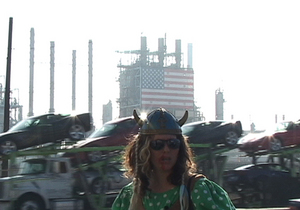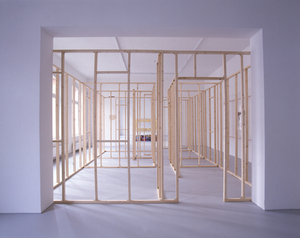This is an archive of the ArtCat Zine, 2007-2009. Please visit our new project, IDIOM.
The kids are alright

Vection, the perception or sensation of motion, decreases with prolonged exposure to movement. Thus after even a short period of travel at high speeds, the body loses its ability to recognize that it is moving at all. In these cases even the appearance of something stationary recovers only the understanding of motion, not the feeling.
It would seem, then, that, for a while now, the Whitney Biennial has served as just such a stationary object. Set to one side of the artistic superhighway, it is relegated the dubious task of reminding us of what we understand but no longer feel; that we are moving very fast indeed. Let those traveling on different roads marvel and squint at what a strange and wonderful playground art has built for itself. Let those not strapped to the hurtling hyperdrive of an industrialized cynicism exclaim: My fellow Americans, the state of the union is strong! It is not for us, we priestly guardians of the tender and delicate critical flame to risk its light by noting, even in passing, how far we may have come. It is not news.

Take the decision to put the Biennial in the hands of two young curators, each well under forty. Well, it's not really theirs, you know? They had help, were overseen, and in any case are firmly entrenched in the institution. Take their subsequent decision to give certain artists their own space to fill as they wished, rather than merely assembling a collection of prefabricated works. Well we've seen that sort of thing before, it shouldn't be understood as any sort of generosity on their or the museum's part, and in any case it fails more often than it succeeds. Take the extension of the show into realms of performance, installation, and general madness at the Park Avenue Armory. Well we can drink Tequila at home, no need to go to a museum for that. Take the almost total absence of painting, still the most widely disseminated shorthand for art in the larger context: would've been more interesting if they'd left it out entirely, Jerry Saltz assures us with a sigh, then at least everyone would have gotten hysterical.
Is that what it takes, Jerry? A giant sign screaming 'No More Painting Ahead'?
The point here is less to demonstrate extensive, structural cynicism, and still less to castigate those who might be most representative of it – Saltz is rarely the problem in this regard. Instead, we might ask, with an artistic practice so omnivorous, so totally coextensive, where might we stand in order to approach something like the 2008 Whitney Biennial with something like an appropriate critical facility. I have tried to sketch what the loss of this standing room implies for our ability to appreciate experimentation and creativity in an institutionalized context, but one could just as easily take the opposite track and demonstrate a similar inability to articulate precisely what is wrong with such gestures. Such a critique would require abstaining radically from the well-worn tropes of Biennial fatigue so as to indicate clearly the social and material stakes in play.
Instead, it seems, we find ourselves in a halfway place, equally incapable of affirming or negating. The curatorial space grants are the clearest example of this, to my mind. Is this practice new? Old? Does it represent a bold effort to link how we think of Biennials - as being comprised chiefly of artists rather than works - with how they are produced? Or is it the opposite, a top-down effort to shift our focus from works towards the artists and their processes? Was it pillaged from Europe? Are we behind the times or ahead of them? Perhaps it's merely a formal triviality, just one more formerly revelatory practice absorbed into the institutional bag of tricks; but isn't this also, in some sense, meaningful? Does that absorption have nothing to say about the parties involved in the transaction, institutional, creative, and otherwise? Isn't something being tested here? Some set of ideas set to work? More to the point, isn't this sort of thing what we've been trying to cultivate? Isn't the combination of self-consciousness and innovation on display in every aspect of this Biennial precisely the result of four decades worth of critical artistic practice and pedagogy? If not, where did we go wrong? And if so, well, what do we think? Where have we succeeded, where have we failed? Quoting, in Peter Schjeldahl's marvelous turn of phrase, that "never-fail appliance for glamorizing malaise,"
– I use the words you taught me. If they don't mean anything any more, teach me others. Or let me be silent.

But they do mean, don't they? Gone are the tight pants and tinfoil trappings of '06 and in their place consolidated, considered reckonings with production, with place, and with history. Gone is the decadent gag-reel Caligula, replaced by Spike Lee's heartrending J'accuse. Here is William Cordova, Leslie Hewitt and Adler Guerrier tackling '68 from three different, complementary and suggestive angles. Here is Phoebe Washburn growing dandelions from Gatorade while Fia Backström has the curators play with clay. Here is Omer Fast's breathtaking demonstration of poly-disciplinary virtuosity, Harry Dodge and Stanya Kahn toting NFL icons, messing about amongst the violent detritus of the city without a team, and Coco Fusco breaking our hearts all over again. Alone, the video and film work is worth the price of admission; and if it wasn't, Daniel Joseph's Divine Violence is again, a startling question begging presentation of the names of all those organizations that sought to be their own last practitioners. There's the night sky in copper rods, a leering wall of aging, vinyl phalluses, and the story of six blind individuals meeting an elephant. Amidst all this are numerous half-baked ideas, over-thought instances of ingrown hermeticism, and good, old-fashioned narcissism. I mean, it's supposed to be American, right?
Much has been made of the supposed theme of the show, 'lessness,' as though the works on display were trying to provincialize and impoverish themselves to the point of barely existing at all, thus opting out of the various economies currently striating the field. Quite frankly, I don't see it. Only one artist, Seth Price, seems to be actively engaged in such a performance of self-marginalization and, given the specifics of his situation and his work, it is altogether interesting and meaningful for him to do so. The rest seem to be arguing, sometime softly, to be sure, but sometimes quite loudly, that there might be more at stake at the present moment than a public demonstration of their own righteousness with regards an overheated market and its corresponding discourse, and that, following perhaps the rest of us need to pull over in order to check the map.
ZINE
HOME
TIPS / COMMENTS
CATEGORIES
CONTRIBUTORS
- Greg Afinogenov
- B. Blagojevic
- Adda Birnir
- Susannah Edelbaum
- Julie Fishkin
- Paddy Johnson
- Jessica Loudis
- Christopher Reiger
- Andrew Robinson
- Peter J. Russo
- Blythe Sheldon
- S.C.Squibb
- Hrag Vartanian
